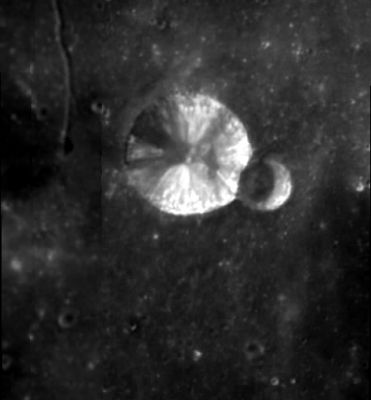Birt
Contents
[hide]Birt
|
Lat: 22.4°S, Long: 8.5°W, Diam: 16 km, Depth: 3.47 km, Rükl: 54 |
Images
LPOD Photo Gallery Lunar Orbiter Images Apollo Images
AS16-120-19224 is one of the Apollo Project's few orbital Hasselblad photographs of Birt / Birt A, and the shadowed Rupes Recta. Research Danny Caes.
The last eight frames of Apollo 16's magazine Revolution 26 (oblique Fairchild camera photographs of the regions south of Apollo 16's orbits) show both Birt and Rupes Recta shortly after local sunrise (depicted near the curved horizon). Research Danny Caes.
Frames 2475 to 2489 of Apollo 16's magazine Revolution 48 show both Birt and Rupes Recta photographed during high sun (depicted near the curved horizon). Research Danny Caes.
Maps
(LAC zone 95A4) LAC map Geologic map
Description
Description: Elger
(IAU Directions) BIRT.--This ring-plain, about 12 miles in diameter, is situated on the Mare Nubium, some distance due W. of Thebit. It has a brilliant border, surmounted by peaks rising more than 2,000 feet above the Mare, and a very depressed floor, which does not appear to contain any visible detail. A bright crater adjoins it on the S.E., the wall of which at the point of junction is clearly very low, so that under oblique light the two interiors appear to communicate by a narrow pass or neck filled with shadow. I have frequently seen a break in the N.E. wall of Birt, which seems to indicate the presence of a crater. There is a noteworthy cleft on the W., which can be traced from the foot of the W. wall to the hills on the N.W. It is a fine telescopic object, and, under some conditions, the wider portion of it resembles a railway cutting traversing rising ground, seen from above. It is visible as a white line under a high light.
Description: Wikipedia
Additional Information
- Depth data from Kurt Fisher database
- Pike, 1976: 3.47 km
- Arthur, 1974: 3.47 km
- Westfall, 2000: 3.47 km
- Viscardy, 1985: 3.47 km
- Cherrington, 1969: 2.34 km
- West rim slope 46° (Pohn, 1963)
- Birt and its satellite crater A are included in ALPO list of bright ray craters
- Included on the ALPO list of banded craters
Nomenclature
- Named for William Radcliffe Birt (1804 - 1881), a British amateur astronomer. He worked extensively with John Herschel, carrying out a great deal of meteorogical research on atmospheric waves, from 1843 to 1850. Seems to have been the inventor of the Homochromascope, an instrument for comparing colours.
- According to Wilkins and Moore, Birt was recognized as one of the most active lunar observers of the 19th century. He has a founder and President of the short-lived Selenographical Society (which published a short-lived Journal) and along with Neison undertook the execution of a map of the Moon in 5 degree square sections for the British Association (for the Advancement of Science). The latter proved an overly ambitious project, and only a very few of the sections were ever completed. An example of one can be seen as Figure 84 in Whitaker. Birt, along with his friend John Lee, also prepared an outline map of the entire Moon on which, according to Whitaker, 85 new names were introduced. Many of these were later adopted by the IAU. - Jim Mosher
- An author query in the NASA bibliographic database turns up 215 articles by Birt, many of which include proposals regarding lunar nomenclature.
- The name Birt appears in two places in Mary Blagg's Collated List: as Catalog number 857 (where it is Julius Schmidt's suggestion for the crater then known as Triesnecker B), and as Catalog number 3063 (where it is Neison's suggestion for the crater known to the other cartographers as Thebit B.
- In the original IAU nomenclature of Named Lunar Formations, Birt was assigned to Catalog number 3063, and Catalog number 857 was given the new name Bruce. A new, and unrelated, Thebit B was introduced by the Nomenclature Committee.
LPOD Articles
New Observations of a Well-Known Area
The Beetle
Succession
The Truth (Kaguya's splendid close up of Birt and Birt A).
No Longer Straight (Kaguya's close up of Rupes Recta, with Birt/ Birt A near the horizon).
Bibliography
- William Radcliff Birt. Astronomical register, vol. 20, pp.12-13 (1882) -- obituary notice
- Birt, W. R. 1863. On the Extension of Lunar Nomenclature. Monthly Notices of the Royal Astronomical Society, Vol. 24, p. 19. -- examples of new names proposed by Birt and Lee
- Birt, W. R. 1864. Recently named Lunar Craters. W. R. Birt, Esq.Astronomische Nachrichten, volume 61, p.213 -- more detail regarding the proposed changes
- The Lunar Surface; Mr. Birt's New Lunar MapAstronomical register, vol. 7, pp.256-257 (1869)
- Savill, M.; McKay, R. The Lunar Crater BirtJournal of the British Astronomical Association/, vol. 91, 463-472. (1981)
- A Portfolio of Lunar Drawings (Harold Hill), pages 104, 105, 106.
W. R. Birt in the Sourcebook Project (William R. Corliss)
- In Mysterious Universe, a handbook of astronomical anomalies (1979) :
- Page 196: On the Obscuration of the Lunar Crater Linne (W.R.Birt, American Journal of Science, 1867).
Articles in which W.R.Birt is mentioned :
- Page 205: Three Riddles of Plato (Jackson T. Carle, Sky and Telescope, 1955).
- Page 358: Zodiacal Light Section, Interim Report (P.B.Molesworth, Journal of the British Astronomical Association, 1900).
- In Tornados, Dark Days, Anomalous Precipitation, and related weather phenomena (1983) :
GWC3-R2: Polarisation of Clouds and Magnetic Phenomena (W.R.Birt, English Mechanic, 1871).
GWC3-R4: Thunderstorm of June 18, 1872 (W.R.Birt, English Mechanic, 1872).
GWP15-R1: On the Production of Lightning by Rain (W.R.Birt, Philosophical Magazine, 1849).
- In Lightning, Auroras, Nocturnal Lights, and related luminous phenomena (1982) :
GLA9-R10: The Aurora and Electricity (W.R.Birt, English Mechanic, 1873).
- In Rare Halos, Mirages, Anomalous Rainbows, and related electromagnetic phenomena (1984) :
GEB5-R1: Remarkable Rainbows (W.R.Birt, English Mechanic, 1871).
